Are you looking for a short moral story translation from Hindi to English (story Translation Hindi To English) suitable for students in Class 5, 9, and 10? We have just the tale for you! This captivating story teaches an important life lesson and has been translated into English to broaden its reach. Students of various ages can benefit from this engaging narrative.
By incorporating this story into their curriculum, educators can foster moral values and cultural appreciation among their students. Discover the transformative power of storytelling and the universal messages it carries, bridging gaps between languages and bringing people closer together.
Best 10 Short Moral Story Translation Hindi To English
Here are ten short moral stories in English that are both entertaining and thought-provoking:
- “The Ant and the Grasshopper”: Learn the value of hard work and planning for the future.
- “The Boy Who Cried Wolf”: Understand the importance of honesty and credibility.
- “The Lion and the Mouse”: Discover the significance of kindness and gratitude, no matter one’s size or stature.
- “The Tortoise and the Hare”: Embrace the lesson of perseverance and the slow but steady approach to success.
- “The Goose that Laid the Golden Eggs”: Realize the importance of contentment and avoiding greed.
- “The Fox and the Grapes”: Learn about overcoming envy and the art of accepting things gracefully.
- “The Boy and the Filberts”: Understand the consequences of greed and impatience.
- “The Honest Woodcutter”: Embrace the value of honesty and how it leads to a better outcome.
- “The Wind and the Sun”: Explore the power of persuasion and kindness over force.
- “The Crow and the Pitcher”: Discover the significance of problem-solving and resourcefulness.
These stories provide valuable life lessons and can be enjoyed by children and adults alike, encouraging reflection and personal growth.
👉 Read also: Best 10 Japanese Love Story’s That Will Sweep You Off Your Feet!
“द एंट एंड द टिड्डा”: कड़ी मेहनत और भविष्य के लिए योजना बनाने का मूल्य जानें।
एक बार की बात है, एक घास के मैदान में एक चींटी और एक टिड्डा रहते थे। चींटी मेहनती थी और अपने दिन भोजन इकट्ठा करने और आने वाली सर्दियों के लिए अपना आश्रय बनाने में लगाती थी। इस बीच, टिड्डी ने भविष्य की चिंता किए बिना अपना समय गाते हुए और धूप का आनंद लेते हुए बिताया।
जैसे-जैसे सर्दियाँ आने लगीं, टिड्डे को एहसास हुआ कि उसके पास कोई भोजन जमा नहीं है। इसने चींटी को देखा , जो आरामदायक थी और अपने आरामदायक आश्रय में अच्छी तरह से तैयार थी। टिड्डे ने चींटी से ठंड के मौसम में बचने के लिए कुछ खाने के लिए कहा ।
चींटी ने जवाब दिया, “जब तुमने अपना समय काम करने के बजाय गायन में बिताया तो मैं तुम्हारी मदद क्यों करूँ ? अब तुम्हें अपने कर्मों के परिणाम भुगतने होंगे।”
इस कहानी से सीख मिलती है कि सुरक्षित भविष्य के लिए कड़ी मेहनत और तैयारी बहुत जरूरी है। यह हमें जिम्मेदार होने और टालमटोल न करने का महत्व सिखाती है , क्योंकि परिश्रम का प्रतिफल अक्सर बाद में मिलता है। तो, आइए हम चींटी से सीखें और जीवन में सफलता और सुरक्षा प्राप्त करने के अपने प्रयासों में मेहनती बनें।
Short Moral Story Translation Hindi To English
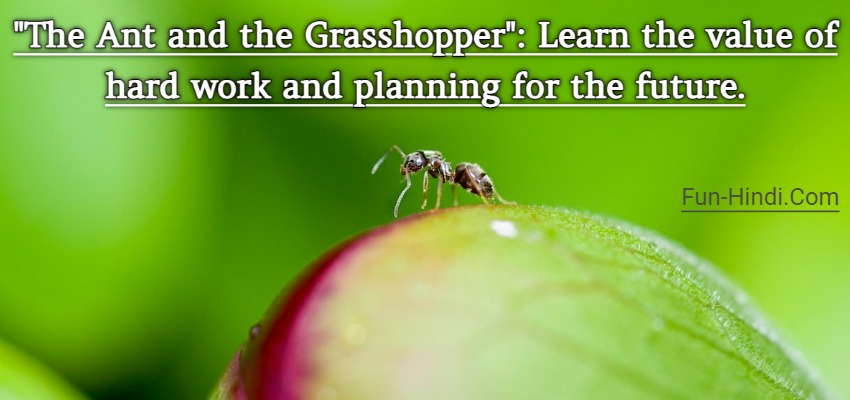
“The Ant and the Grasshopper”: Learn the value of hard work and planning for the future.
Once upon a time, there lived an ant and a grasshopper in a meadow. The ant was hardworking and spent its days collecting food and building its shelter for the upcoming winter. Meanwhile, the grasshopper spent its time singing and enjoying the sunshine without worrying about the future.
As winter approached, the grasshopper realized that it had no food stored. It looked at the ant, who was snug and well-prepared in its cozy shelter. The grasshopper asked the ant for some food to survive the cold season.
The ant replied, “Why should I help you when you spent your time singing instead of working? Now you must face the consequences of your actions.”
The moral of the story is that hard work and preparation are vital for a secure future. It teaches us the importance of being responsible and not procrastinating, as the rewards of diligence are often reaped later. So, let us learn from the ant and be diligent in our endeavors to achieve success and security in life.
👉 Read also: Kapil Sharma Biography & Comedy Life Introduction
“द बॉय हू क्राईड वुल्फ”: ईमानदारी और विश्वसनीयता के महत्व को समझें।
एक बार की बात है, एक गाँव में एक युवा चरवाहा लड़का रहता था। उनका दैनिक कार्य गाँव की भेड़ों की देखभाल करना, किसी भी नुकसान से उनकी सुरक्षा सुनिश्चित करना था। हालाँकि, लड़का काफी शरारती था और उसे गाँव वालों के साथ मज़ाक करने में मज़ा आता था।
एक धूप वाले दिन, ऊब महसूस करते हुए, लड़के ने कुछ मज़ा करने का फैसला किया। वह गाँव के ऊपर एक पहाड़ी पर चढ़ गया और अपने फेफड़ों के शीर्ष पर चिल्लाया, “भेड़िया! भेड़िया! एक भेड़िया भेड़ पर हमला कर रहा है!”
बच्चे के रोने की आवाज सुनकर ग्रामीण घबरा गए और बच्चे को बचाने के लिए दौड़ पड़े। लेकिन जब वे पहाड़ी की चोटी पर पहुंचे तो उन्हें कोई भेड़िया नहीं मिला। चिंतित ग्रामीणों की दृष्टि का आनंद लेते हुए लड़का हँसी में फूट पड़ा। उसने सोचा कि बिना किसी कारण के उन्हें अपने बचाव के लिए भागते देखना प्रफुल्लित करने वाला था।
कुछ दिनों बाद लड़के ने अपनी शरारत दोहराई। एक बार फिर वह चिल्लाया, “भेड़िया! भेड़िया! भेड़िया भेड़ों पर हमला कर रहा है!”
पिछली घटना को याद कर ग्रामीण इस बार संशय में थे। कुछ ने लड़के को नज़रअंदाज़ कर दिया, यह सोचकर कि वह फिर से अपनी चाल पर चल रहा है, जबकि अन्य जवाब देने से पहले झिझक रहे थे। आखिरकार, कुछ जिज्ञासु ग्रामीण पहाड़ी पर चढ़ गए, केवल यह पता लगाने के लिए कि कोई भेड़िया नहीं था। लड़का और भी ज़ोर से हँसा, अपने सफल मज़ाक का मज़ाक उड़ाते हुए।
हालाँकि, उनकी शरारतों के परिणाम थे। लड़के के लगातार रोने से भेड़ें भयभीत और बेचैन हो गई थीं। गांववालों का लड़के पर से भरोसा उठने लगा और उसके रोने पर उनकी प्रतिक्रिया का समय धीमा हो गया।
एक दिन, जब लड़का भेड़ों को देख रहा था, एक असली भेड़िया प्रकट हुआ। यह झुंड पर चढ़ गया और भेड़ों पर हमला करना शुरू कर दिया। भयभीत होकर, लड़का बुरी तरह चिल्लाया, “भेड़िया! भेड़िया! कृपया मदद करें!”
इस बार ग्रामीण लड़के की चीख पर विश्वास करने से हिचकिचा रहे थे। उन्होंने पिछली झूठी चेतावनी को याद किया और सोचा कि यह उनकी एक और शरारत है। ग्रामीणों ने उसके बचाव में नहीं आने का फैसला किया।
बेबसी से, लड़के ने देखा कि भेड़िये ने कई भेड़ों को मार डाला और बाकी को तितर-बितर कर दिया। उसे अपनी गलती की गंभीरता का एहसास हुआ, उसे अपने पिछले कार्यों पर पछतावा हो रहा था। गांव वालों ने उन पर भरोसा करना छोड़ दिया था और अब जब उन्हें उनकी सबसे ज्यादा जरूरत थी तो वे वहां नहीं थे।
कहानी का नैतिक यह है कि ईमानदारी और विश्वास मूल्यवान गुण हैं। यह हमें सिखाता है कि दूसरों को धोखा न दें या अपने मनोरंजन के लिए उनके भरोसे का फायदा न उठाएं। एक बार भरोसा खो जाने के बाद दोबारा हासिल करना मुश्किल होता है।
Short Moral Story Translation Hindi To English

“The Boy Who Cried Wolf”: Understand the importance of honesty and credibility.
Once upon a time, in a village, there lived a young shepherd boy. His daily task was to take care of the village sheep, ensuring their safety from any harm. However, the boy was quite mischievous and enjoyed playing pranks on the villagers.
One sunny day, feeling bored, the boy decided to have some fun. He climbed up a hill overlooking the village and shouted at the top of his lungs, “Wolf! Wolf! A wolf is attacking the sheep!”
Hearing the boy’s cry, the villagers panicked and rushed to the boy’s aid. But when they reached the top of the hill, they found no wolf. The boy burst into laughter, enjoying the sight of the worried villagers. He thought it was hilarious to see them running to his rescue for no reason.
A few days later, the boy repeated his prank. Once again, he cried out, “Wolf! Wolf! The wolf is attacking the sheep!”
The villagers, remembering the last incident, were skeptical this time. Some ignored the boy, thinking he was up to his tricks again, while others hesitated before responding. Eventually, a few curious villagers climbed up the hill, only to discover that there was no wolf. The boy laughed even harder, reveling in his successful prank.
However, his pranks had consequences. The sheep had become fearful and restless due to the boy’s constant cries. The villagers began losing trust in the boy, and their response time to his cries became slower.
One day, while the boy was watching over the sheep, a real wolf appeared. It sneaked up on the flock and started attacking the sheep. Terrified, the boy desperately cried out, “Wolf! Wolf! Please help!”
This time, the villagers were hesitant to believe the boy’s cries. They remembered the previous false alarms and thought it was just another one of his pranks. The villagers decided not to come to his rescue.
Helplessly, the boy watched as the wolf killed several sheep and scattered the rest. He realized the severity of his mistake, regretting his previous actions. The villagers had stopped trusting him, and now, when he needed them the most, they were not there.
The moral of the story is that honesty and trust are valuable qualities. It teaches us not to deceive others or take advantage of their trust for our amusement. Once trust is lost, it is difficult to regain.
👉 Read also: Facebook vip bio stylish attitude for girls and boys (1000+)
“द लायन एंड द माउस”: किसी के आकार या कद से कोई फर्क नहीं पड़ता, दया और कृतज्ञता के महत्व की खोज करें।
एक घने जंगल के बीच में, एक शक्तिशाली शेर धूप सेंक रहा था, उसकी शक्तिशाली मांसपेशियां उसके सुनहरे अयाल के नीचे हिल रही थीं। जब वह आराम कर रहा था, तो एक छोटा सा चूहा शेर के पंजों के नीचे छिपे खतरे से बेखबर भागता हुआ आया। संयोग से, चूहा शेर की पूंछ से टकरा गया और उसे उसकी नींद से जगा दिया।
गुस्से में शेर ने अपने विशाल पंजे से चूहे को पकड़ लिया। छोटा जीव दया की याचना करते हुए डर से कांपने लगा। चूहे ने याचना की, “कृपया, शेर साहब, मेरी जान बख़्श दीजिए। मैं वादा करता हूँ कि अगर आप मुझे जाने देंगे तो मैं किसी दिन आपकी दया का बदला चुकाऊँगा।”
चूहे की बातों से शेर चकित हो गया और बोला, “तुम मुझे चुका दो? तुम्हारे जैसा छोटा प्राणी मेरे लिए क्या कर सकता है?”
हालाँकि, शेर की जिज्ञासा ने उसे बेहतर कर दिया, और उसने यह सोचकर चूहे को छोड़ने का फैसला किया कि यह हानिरहित है।
साल बीत गए, और एक दिन, शक्तिशाली शेर ने खुद को एक शिकारी के जाल में फँसा पाया। अपनी पूरी ताकत से दहाड़ते हुए, उसने मुक्त होने के लिए संघर्ष किया लेकिन असफल रहा। उसे बाँधने वाली तंग रस्सियों के आगे उसकी अपार शक्ति बेकार थी।
शेर की चीख सुनकर छोटा चूहा घटनास्थल की ओर दौड़ा। बिना किसी हिचकिचाहट के, उसने रस्सियों को चबाया, तब तक अथक परिश्रम किया जब तक कि शेर अंत में आज़ाद नहीं हो गया। शेर, जो अब विनम्र और कृतज्ञ था, ने चूहे को बहुत धन्यवाद दिया।
कहानी का नैतिक यह है कि दया और कृतज्ञता अप्रत्याशित स्रोतों से आ सकती है। यह हमें सिखाता है कि दयालुता का कोई भी कार्य कभी व्यर्थ नहीं जाता, चाहे वह कितना ही छोटा क्यों न हो। जिस तरह शेर ने चूहे की जान बख्श दी थी, उसी तरह चूहे ने उस एहसान का बदला चुकाया जब शेर को मदद की सबसे ज्यादा जरूरत थी।
इस कहानी में महत्वपूर्ण शब्द हैं:
- सिंह : शक्ति और शक्ति का प्रतिनिधित्व करता है।
- माउस : लघुता और तुच्छता का प्रतीक है।
- दयालुता : दूसरों के प्रति करुणा और सहानुभूति प्रदर्शित करना।
- कृतज्ञता : दयालुता के कृत्यों के लिए प्रशंसा महसूस करना और व्यक्त करना।
- मदद : जरूरत के समय दूसरों की मदद करना।
- चुकाया हुआ : वचन पूरा करना या एहसान लौटाना।
Short Moral Story Translation Hindi To English
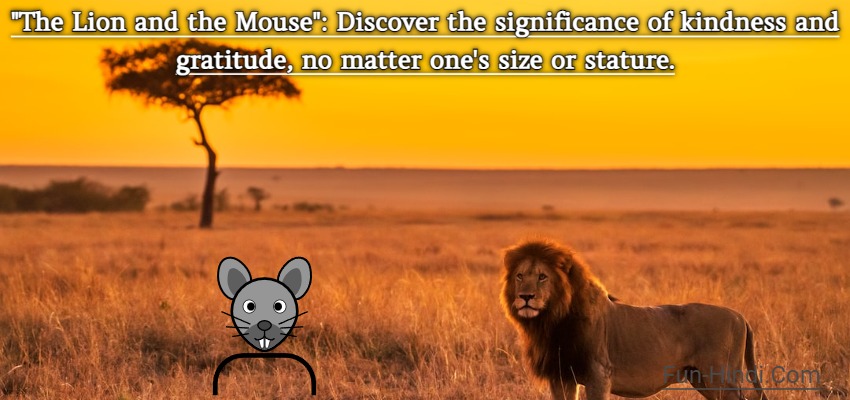
“The Lion and the Mouse”: Discover the significance of kindness and gratitude, no matter one’s size or stature.
In the heart of a dense jungle, a mighty lion lay basking in the sun, his powerful muscles rippling under his golden mane. As he rested, a tiny mouse scurried by, unaware of the danger lurking beneath the lion’s paws. Accidentally, the mouse tripped over the lion’s tail and woke him from his slumber.
Enraged, the lion grabbed the mouse with his massive paw. The little creature trembled with fear, pleading for mercy. The mouse begged, “Please, Mr. Lion, spare my life. I promise to repay your kindness someday, if only you let me go.”
Amused by the mouse’s words, the lion chuckled and said, “You, repay me? What could a tiny creature like you possibly do for me?”
However, the lion’s curiosity got the better of him, and he decided to release the mouse, thinking it was harmless.
Years passed, and one day, the mighty lion found himself trapped in a hunter’s net. Roaring with all his might, he struggled to break free but failed. His immense strength was useless against the tight ropes that bound him.
Hearing the lion’s cries, the little mouse rushed to the scene. Without hesitation, it gnawed on the ropes, working tirelessly until the lion was finally set free. The lion, now humbled and grateful, thanked the mouse profusely.
The moral of the story is that kindness and gratitude can come from unexpected sources. It teaches us that no act of kindness is ever wasted, no matter how small. Just as the lion had spared the mouse’s life, the mouse repaid the favor when the lion needed help the most.
In this story, the important words are:
- Lion: Represents power and strength.
- Mouse: Symbolizes smallness and insignificance.
- Kindness: Demonstrating compassion and empathy towards others.
- Gratitude: Feeling and expressing appreciation for acts of kindness.
- Help: Assisting others in their time of need.
- Repaid: Fulfilling a promise or returning a favor.
👉 Read also: instagram vip bio stylish font for girls and boys (100+)
“कछुआ और खरगोश”: दृढ़ता और सफलता के लिए धीमी लेकिन स्थिर दृष्टिकोण का पाठ गले लगाओ।
एक बार की बात है, एक जीवंत जंगल में, एक कछुआ और एक खरगोश रहते थे । खरगोश अपनी अविश्वसनीय गति और घमंडी स्वभाव के लिए जाना जाता था, जबकि कछुआ धीमा और स्थिर था। खरगोश अक्सर कछुआ की धीमी गति के लिए उसका उपहास करता था, उसे श्रेष्ठता के शब्दों के साथ ताना मारता था।
एक दिन खरगोश के लगातार चिढ़ाने से तंग आकर कछुए ने खरगोश को दौड़ के लिए चुनौती देने का फैसला किया। इस विचार से चकित खरगोश ने इस चुनौती को आसानी से स्वीकार कर लिया। इस अनोखे मुकाबले को देखने के लिए जंगल के जानवर इकट्ठे हो गए।
दौड़ शुरू होते ही खरगोश तेजी से आगे बढ़ गया और कछुआ बहुत पीछे रह गया। जीत के प्रति आश्वस्त, खरगोश ने एक छायादार पेड़ के नीचे झपकी लेने का फैसला किया, यह सोचकर कि अभी उसके पास जीतने के लिए बहुत समय होगा।
इस बीच, कछुआ अपनी गति से, धीमी लेकिन दृढ़ संकल्प के साथ चला। यह आगे बढ़ता गया, अपने पाठ्यक्रम से कभी नहीं डगमगाया। खरगोश के समर्थकों की हँसी और मज़ाक के बावजूद, कछुआ पूरी तरह से फिनिश लाइन तक पहुँचने पर केंद्रित था।
जब खरगोश जागा, तो कछुए को दौड़ के अंत के करीब देखकर चकित रह गया। तेजी के साथ, खरगोश फिनिश लाइन की ओर दौड़ा, लेकिन तब तक बहुत देर हो चुकी थी। कछुआ फिनिश लाइन पार कर रेस जीत गया।
कहानी का नैतिक यह है कि दृढ़ता और एक स्थिर दृष्टिकोण सफलता की ओर ले जाता है । यह हमें सिखाता है कि निरंतरता और कड़ी मेहनत की शक्ति को कम मत समझो। अपनी प्रारंभिक गति और प्रतिभा के बावजूद, अति आत्मविश्वास और आलस्य के कारण खरगोश दौड़ हार गया। कछुआ, हालांकि धीमा, साबित कर दिया कि दृढ़ संकल्प और निरंतर प्रगति अहंकार पर विजय प्राप्त कर सकती है।
इस कहानी में महत्वपूर्ण शब्द हैं:
- कछुआ : दृढ़ता, दृढ़ संकल्प और एक स्थिर दृष्टिकोण का प्रतीक है।
- खरगोश : गति, अहंकार और अति आत्मविश्वास का प्रतिनिधित्व करता है।
- रेस : एक चुनौती या प्रतियोगिता का प्रतीक है।
- दृढ़ता : निरंतर प्रयास और बाधाओं के बावजूद प्रतिबद्ध रहना।
- सफलता : वांछित परिणाम या लक्ष्य प्राप्त करना।
- संगति : एक नियमित और स्थिर दृष्टिकोण बनाए रखना।
- कठिन परिश्रम : किसी कार्य या उद्देश्य के प्रति परिश्रमी प्रयास और प्रतिबद्धता।
- अतिआत्मविश्वास : किसी की क्षमताओं में अत्यधिक विश्वास, जिससे आत्मसंतोष होता है।
- आलस्य : किसी कार्य को पूरा करने के लिए प्रेरणा या प्रयास की कमी।
- विजय : विजय या उपलब्धि।
Short Moral Story Translation Hindi To English
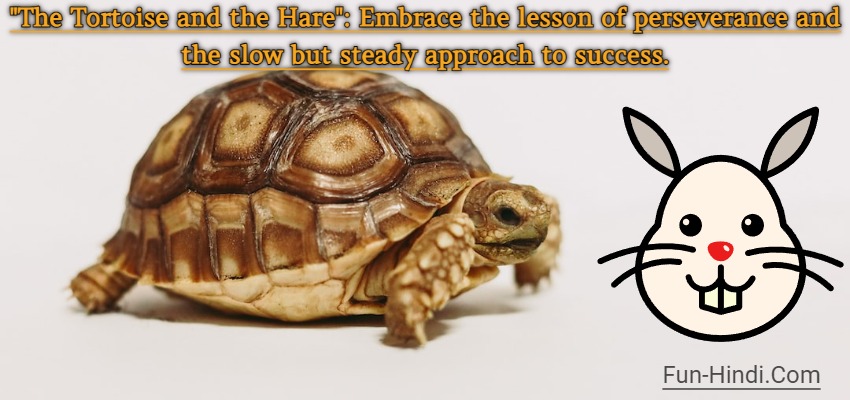
“The Tortoise and the Hare”: Embrace the lesson of perseverance and the slow but steady approach to success.
Once upon a time, in a lively forest, there lived a tortoise and a hare. The hare was known for its incredible speed and boastful nature, while the tortoise was slow and steady. The hare would often mock the tortoise for its sluggish pace, taunting it with words of superiority.
One day, tired of the hare’s constant teasing, the tortoise decided to challenge the hare to a race. The hare, amused by the idea, readily accepted the challenge. The animals of the forest gathered to witness this unusual contest.
As the race began, the hare zoomed ahead, leaving the tortoise far behind. Confident of victory, the hare decided to take a nap under a shady tree, thinking it would still have plenty of time to win.
Meanwhile, the tortoise trudged along at its own pace, slow but determined. It plodded forward, never wavering from its course. Despite the laughter and mockery from the hare’s supporters, the tortoise focused solely on reaching the finish line.
When the hare woke up, it was astonished to see the tortoise nearing the end of the race. With a burst of speed, the hare sprinted towards the finish line, but it was too late. The tortoise crossed the finish line, winning the race.
The moral of the story is that perseverance and a steady approach lead to success. It teaches us not to underestimate the power of consistency and hard work. The hare, despite its initial speed and talent, lost the race due to overconfidence and laziness. The tortoise, although slow, proved that determination and steady progress can triumph over arrogance.
In this story, the important words are:
- Tortoise: Symbolizes persistence, determination, and a steady approach.
- Hare: Represents speed, arrogance, and overconfidence.
- Race: Signifies a challenge or competition.
- Perseverance: Continuing efforts and staying committed despite obstacles.
- Success: Achieving a desired outcome or goal.
- Consistency: Maintaining a regular and steady approach.
- Hard work: Diligent effort and commitment towards a task or objective.
- Overconfidence: Excessive belief in one’s abilities, leading to complacency.
- Laziness: Lack of motivation or effort to accomplish a task.
- Triumph: Victory or achievement.
👉 Read also: Yogi Adityanath Biography & Life introduction
“द हंस दैट दैट गोल्डन एग्स”: संतोष के महत्व को समझें और लालच से बचें।
एक बार की बात है, एक शांत ग्रामीण इलाके में एक गरीब किसान और उसकी पत्नी रहते थे। उन्होंने अपनी जरूरतों को पूरा करने के लिए संघर्ष किया और बेहतर जीवन के सपने देखे। एक दिन, उनकी किस्मत बदल गई जब उन्हें सोने के अंडे देने वाली एक बत्तख मिली । यह एक चमत्कारी उपहार था जो उनके लिए बहुत धन और खुशी लेकर आया।
हर दिन हंस एक चमकीला सुनहरा अंडा देती। खुश होकर किसान और उसकी पत्नी ने अंडे एकत्र किए और उन्हें बाजार में बेच दिया। उन्होंने जो पैसा कमाया, उससे उन्होंने अपने रहने की स्थिति में सुधार किया और एक आरामदायक जीवन व्यतीत किया। हालाँकि, अधिक धन की उनकी इच्छा हर दिन मजबूत होती गई।
लालच से प्रेरित किसान की पत्नी के मन में एक दुष्ट विचार आया। उसने अपने पति को आश्वस्त किया कि हंस के पेट के अंदर सोने के अंडों का खजाना होना चाहिए। उसने जोर देकर कहा कि उन्हें एक ही बार में सभी अंडे प्राप्त करने के लिए हंस को मार देना चाहिए।
किसान, अपनी पत्नी के अनुनय का विरोध करने में असमर्थ, उसकी योजना के लिए सहमत हो गया। उसने छिपे हुए खजाने को खोजने के लिए उत्सुक हंस को मार डाला। हालाँकि, उनके निराशा के लिए, उन्हें हंस के पेट के अंदर कोई सुनहरा अंडा नहीं मिला। उन्होंने अपने धन और सुख के एकमात्र स्रोत को मार डाला था।
दंपति को अपनी भयानक गलती का एहसास हुआ। उन्होंने अपने लालच को अपने फैसले पर हावी होने दिया था, और अब उनके पास कुछ भी नहीं बचा था। उन्हें अपने किए पर पछतावा हुआ, यह समझते हुए कि उनकी अधीरता और लोभ ने उन्हें बहुत महंगा पड़ा।
कहानी का नैतिक यह है कि संतोष और लोभ से बचना महत्वपूर्ण गुण हैं। यह हमें लगातार और अधिक चाहने के बजाय जो कुछ भी है उसके लिए सराहना करना और आभारी होना सिखाता है। दंपत्ति के निरंकुश लालच ने उनके पतन का कारण बना, और उन्होंने कठिन तरीका सीखा कि सच्चा धन जो है उससे संतुष्ट होने में निहित है।
इस कहानी में महत्वपूर्ण शब्द हैं:
- हंस : धन और खुशी के स्रोत का प्रतिनिधित्व करता है।
- सुनहरे अंडे : मूल्यवान और कीमती पुरस्कारों का प्रतीक।
- गरीब किसान : एक विनम्र और संघर्षशील व्यक्ति का प्रतिनिधित्व करता है।
- धन : भौतिक समृद्धि और प्रचुरता।
- खुशी : भावनात्मक भलाई और संतोष।
- लोभ : धन या संपत्ति की अत्यधिक इच्छा।
- अभिलाषा : किसी वस्तु की लालसा या लालसा।
- संतोष : किसी के पास जो है उसके लिए संतुष्टि और प्रशंसा।
- अफ़सोस : पिछले कार्यों के लिए पश्चाताप या दुख की भावना।
- अधोगति : गलत विकल्पों के कारण नकारात्मक परिणाम या हानि।
Short Moral Story Translation Hindi To English
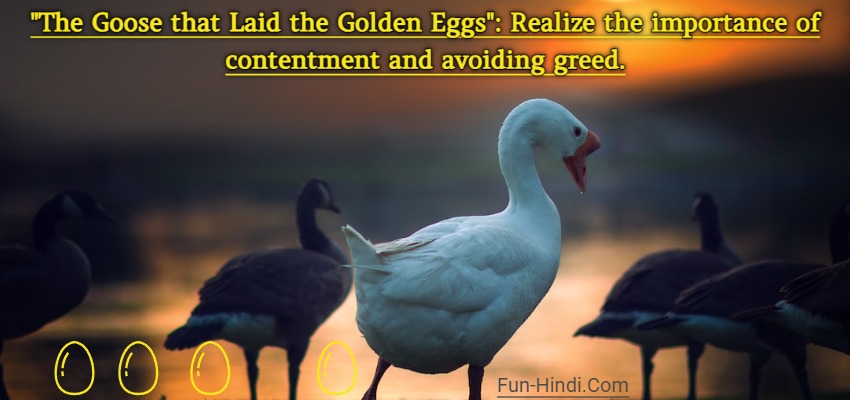
“The Goose that Laid the Golden Eggs”: Realize the importance of contentment and avoiding greed.
Once upon a time, in a quiet countryside, there lived a poor farmer and his wife. They struggled to make ends meet and dreamed of a better life. One day, their luck changed when they discovered a goose that laid golden eggs. It was a miraculous gift that brought them great wealth and happiness.
Every day, the goose would lay a shiny golden egg. Overjoyed, the farmer and his wife collected the eggs and sold them in the market. With the money they earned, they improved their living conditions and lived a comfortable life. However, their desire for more wealth grew stronger each day.
Driven by greed, the farmer’s wife had a wicked idea. She convinced her husband that the goose must have a treasure trove of golden eggs inside its belly. She insisted they should kill the goose to acquire all the eggs at once.
The farmer, unable to resist his wife’s persuasion, agreed to her plan. He killed the goose, eager to find the hidden treasure. However, to their dismay, they found no golden eggs inside the goose’s belly. They had killed their only source of wealth and happiness.
The couple realized their terrible mistake. They had let their greed cloud their judgment, and now they were left with nothing. They regretted their actions, understanding that their impatience and avarice had cost them dearly.
The moral of the story is that contentment and avoiding greed are important virtues. It teaches us to appreciate and be grateful for what we have instead of constantly desiring more. The couple’s unbridled greed led to their downfall, and they learned the hard way that true wealth lies in being satisfied with what one has.
In this story, the important words are:
- Goose: Represents a source of wealth and happiness.
- Golden eggs: Symbolize valuable and precious rewards.
- Poor farmer: Represents a humble and struggling individual.
- Wealth: Material prosperity and abundance.
- Happiness: Emotional well-being and contentment.
- Greed: Excessive desire for wealth or possessions.
- Desire: Craving or longing for something.
- Contentment: Satisfaction and appreciation for what one has.
- Regret: Feeling of remorse or sadness for past actions.
- Downfall: Negative consequences or loss due to poor choices.
👉 Read also: Narendra Modi Biography & Life Introduction
“द फॉक्स एंड द ग्रेप्स”: ईर्ष्या पर काबू पाने और चीजों को शान से स्वीकार करने की कला के बारे में जानें।
घने जंगल में, एक चतुर लोमड़ी भोजन की तलाश में अपनी तेज आँखों के साथ टहल रही थी। बहुत दिन हो गए थे, और लोमड़ी का पेट भूख से लड़खड़ा रहा था। तभी उसकी नज़र एक बेल से लटकते हुए अंगूर के रसीले गुच्छे पर पड़ी।
स्वादिष्ट भोजन की संभावना से उत्साहित, लोमड़ी उछल पड़ी, अंगूरों तक पहुँचने की कोशिश कर रही थी। लेकिन कितनी भी कोशिश करने के बाद भी अंगूर पहुंच से बाहर ही रहे। कई असफल प्रयासों के बाद, लोमड़ी थक गई और निराश हो गई।
पराजित महसूस करते हुए, लोमड़ी ने आखिरकार हार मान ली और चली गई। जैसे ही वह चला गया, लोमड़ी ने कहा, “वे अंगूर वैसे भी खट्टे हैं। मुझे यकीन है कि वे प्रयास के लायक नहीं हैं।”
कहानी का नैतिक यह है कि ईर्ष्या पर काबू पाना और चीजों को शालीनता से स्वीकार करना महत्वपूर्ण है। यह हमें सिखाता है कि हम किसी चीज का सिर्फ इसलिए अवमूल्यन या महत्व कम न करें क्योंकि वह हमारे पास नहीं है। लोमड़ी, अंगूरों तक पहुँचने में असमर्थ, अपनी असफलता को स्वीकार करने के बजाय खुद को आश्वस्त करती थी कि वे अवांछनीय हैं।
इस कहानी में महत्वपूर्ण शब्द हैं:
- लोमड़ी : चालाकी और चतुराई का प्रतिनिधित्व करती है।
- अंगूर : किसी वांछनीय या अप्राप्य वस्तु का प्रतीक।
- भूख : अत्यधिक आवश्यकता या लालसा का अनुभव होना।
- स्वादिष्ट : स्वाद या मन को भाने वाला।
- पहुँचना : किसी वस्तु की प्राप्ति या पहुँच।
- पराजित : परास्त या असफल होने का भाव।
- ईर्ष्या : दूसरों के पास मौजूद किसी चीज़ की इच्छा।
- शान से : बिना कड़वाहट के निराशा या हानि को स्वीकार करना।
- खट्टा : स्वाद में अप्रिय या अवांछनीय।
- असफलता : सफलता का अभाव या वांछित परिणाम प्राप्त करना।
Short Moral Story Translation Hindi To English

“The Fox and the Grapes”: Learn about overcoming envy and the art of accepting things gracefully.
In a dense forest, a clever fox strolled along, its sharp eyes searching for food. It had been a long day, and the fox’s stomach rumbled with hunger. Just then, it caught sight of a luscious bunch of grapes hanging from a vine.
Excited by the prospect of a delicious meal, the fox jumped up, trying to reach the grapes. But no matter how hard it tried, the grapes remained just out of reach. After several unsuccessful attempts, the fox grew tired and frustrated.
Feeling defeated, the fox finally gave up and walked away. As it left, the fox muttered, “Those grapes are probably sour anyway. I’m sure they’re not worth the effort.”
The moral of the story is that overcoming envy and accepting things gracefully is important. It teaches us not to devalue or belittle something just because we cannot have it. The fox, unable to reach the grapes, convinced itself that they were undesirable rather than accepting its own failure.
In this story, the important words are:
- Fox: Represents cunning and cleverness.
- Grapes: Symbolize something desirable or unattainable.
- Hunger: Feeling of intense need or craving.
- Delicious: Pleasing to the taste or desirable.
- Reach: Attaining or accessing something.
- Defeated: Feeling of being overcome or unsuccessful.
- Envy: Desire for something possessed by others.
- Gracefully: Accepting disappointment or loss without bitterness.
- Sour: Unpleasant or undesirable in taste.
- Failure: Lack of success or achieving a desired outcome.
👉 Read also: Unique Baby Boy Name List In Hindi (A to Z) {2023}
“द बॉय एंड द फिल्बर्ट्स”: लालच और अधीरता के परिणामों को समझें।
एक बार की बात है, एक छोटे से गांव में एक लड़का रहता था। एक दिन, जब वह जंगल से गुजर रहा था, पके फीलबर्ट्स —एक प्रकार के अखरोट—से लदे एक पेड़ से उसकी मुलाकात हो गई। अपनी खोज से उत्साहित होकर, लड़का उत्सुकता से स्वादिष्ट फिलबर्ट को चुनने और खाने लगा।
जैसा कि उसने प्रत्येक अखरोट का स्वाद चखा, वह अधिक खाने के प्रलोभन का विरोध नहीं कर सका। लड़के की भूख बहुत तेज थी और वह एक ही बार में सभी फिल्बर्ट्स का आनंद लेना चाहता था। बिना सोचे-समझे उसने अपने मुंह में ज्यादा से ज्यादा फिलबर्ट भरने का फैसला किया।
अपने निराश करने के लिए, लड़के को जल्द ही एहसास हुआ कि उसने अपना मुंह भर लिया है। वह कितनी भी कोशिश कर ले, वह अत्यधिक मात्रा में मेवों को न तो चबा सकता है और न ही निगल सकता है। उसके गाल फूले हुए थे, और वह मुश्किल से सांस ले पा रहा था।
घबरा गया और बोलने में असमर्थ होने के कारण लड़का चिंता करने लगा। उसे लालची होने और अपनी क्षमता से अधिक पाने की कोशिश करने की अपनी गलती का एहसास हुआ । उन्होंने उचित मात्रा में फिल्बर्ट्स से संतुष्ट नहीं होने पर खेद व्यक्त किया।
शुक्र है कि एक बूढ़े राहगीर ने लड़के की परेशानी देख ली। समस्या को भांपते हुए, बुद्धिमान व्यक्ति मुस्कुराया और कहा, “मेरे प्यारे लड़के, ऐसा लगता है कि तुमने एक मूल्यवान सबक सीख लिया है। याद रखें, लालच परेशानी की ओर ले जाता है। अधिक के लिए सब कुछ जोखिम में डालने के बजाय आपके पास जो है उससे संतुष्ट रहना बेहतर है।”
बूढ़ा आदमी बाहर पहुंचा और लड़के को एक गिलास पानी थमा दिया। जैसे ही लड़के ने पानी पिया, उसके सूजे हुए गाल धीरे-धीरे सामान्य हो गए, और वह फिर से खुलकर सांस लेने में सक्षम हो गया।
उस दिन से लड़के ने जो कुछ उसके पास था उससे संतुष्ट रहना और जीवन में साधारण सुखों की सराहना करना सीख लिया। वह समझ गया कि लालच केवल अस्थायी संतुष्टि लाता है और अक्सर अवांछनीय परिणाम देता है।
कहानी का नैतिक यह है कि लालच और अधीरता के नकारात्मक परिणाम हो सकते हैं, जबकि संतोष शांति और खुशी लाता है। यह हमें सिखाता है कि हमारे पास जो है उसकी सराहना करें और हमेशा और अधिक चाहने के प्रलोभन से बचें।
इस कहानी में महत्वपूर्ण शब्द हैं:
- लड़का : एक युवा व्यक्ति का प्रतिनिधित्व करता है जो अनुभव के माध्यम से सबक सीखता है।
- फिल्बर्ट्स : एक वांछनीय वस्तु या आनंद का प्रतीक है।
- प्रलोभन : किसी चीज की प्रबल इच्छा।
- लोभी : एक से अधिक आवश्यकताओं की अत्यधिक इच्छा होना।
- अफ़सोस : अपने किए पर निराशा या पश्चाताप का भाव।
- सामग्री : किसी के पास जो है उससे संतुष्ट होना और उसकी सराहना करना।
- परेशानी : नकारात्मक परिणाम या कठिनाइयाँ।
- पाठ : अनुभव से प्राप्त ज्ञान या ज्ञान।
- अधीरता : धैर्य की कमी या प्रतीक्षा करने की इच्छा।
- परिणाम : कार्यों के परिणाम या परिणाम।
Short Moral Story Translation Hindi To English
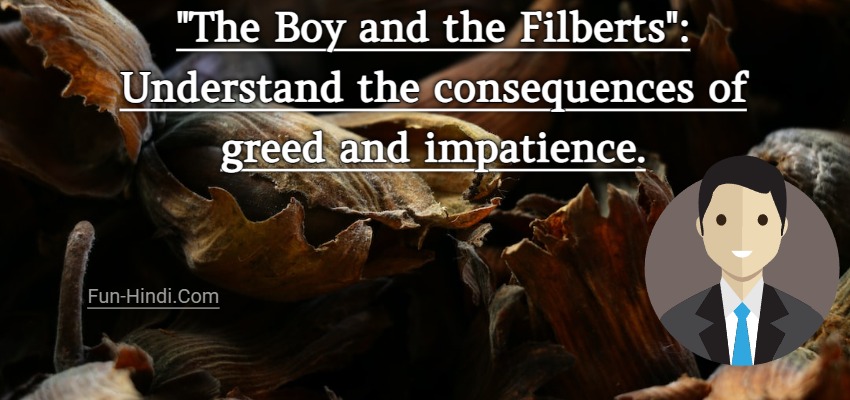
“The Boy and the Filberts”: Understand the consequences of greed and impatience.
Once upon a time, there was a boy who lived in a small village. One day, while walking through the woods, he stumbled upon a tree laden with ripe filberts—a kind of nut. Excited by his discovery, the boy eagerly started picking and eating the delicious filberts.
As he relished the taste of each nut, he couldn’t resist the temptation to have more. The boy had a voracious appetite and wanted to enjoy all the filberts at once. Without thinking, he decided to stuff as many filberts as possible into his mouth.
To his dismay, the boy soon realized that he had overfilled his mouth. Try as he might, he couldn’t chew or swallow the excessive amount of nuts. His cheeks were puffed up, and he could hardly breathe.
Panicked and unable to speak, the boy began to worry. He realized his mistake of being greedy and trying to have more than he could handle. He regretted not being content with a reasonable amount of filberts.
Thankfully, an old passerby noticed the boy’s distress. Sensing the problem, the wise man smiled and said, “My dear boy, it seems you have learned a valuable lesson. Remember, greediness leads to trouble. It is better to be content with what you have rather than risking everything for more.”
The old man reached out and handed the boy a glass of water. As the boy sipped the water, his swollen cheeks gradually returned to normal, and he was able to breathe freely again.
From that day forward, the boy learned to be content with what he had and to appreciate the simple pleasures in life. He understood that greed only brings temporary satisfaction and often leads to undesirable consequences.
The moral of the story is that greed and impatience can have negative consequences, while contentment brings peace and happiness. It teaches us to appreciate what we have and to avoid the temptation of always wanting more.
In this story, the important words are:
- Boy: Represents a young individual who learns a lesson through experience.
- Filberts: Symbolize a desirable object or pleasure.
- Temptation: A strong desire for something.
- Greedy: Having an excessive desire for more than one needs.
- Regret: Feeling of disappointment or remorse for one’s actions.
- Content: Being satisfied and appreciative of what one has.
- Trouble: Negative consequences or difficulties.
- Lesson: Knowledge or wisdom gained from an experience.
- Impatience: Lack of patience or willingness to wait.
- Consequences: Results or outcomes of actions.
👉 Read also: Girlfriend, Boyfriend, Husband, Wife Love Letter In Hindi With PDF |
“ईमानदार लकड़हारा”: ईमानदारी के मूल्य को गले लगाओ और यह कैसे बेहतर परिणाम की ओर ले जाता है।
एक बार की बात है, हरे-भरे पेड़ों के बीच बसे एक छोटे से गांव में एक ईमानदार लकड़हारा रहता था । उन्होंने अपना और अपने परिवार का भरण-पोषण करने के लिए अथक परिश्रम किया। हर दिन, वह बाजार में बेचने के लिए लकड़ी काटकर पास के जंगल में जाता था।
एक गर्म गर्मी के दिन, जैसे ही लकड़हारे ने अपनी कुल्हाड़ी घुमाई, वह उसके हाथ से फिसल गई और गहरी नदी में गिर गई। तबाह हो गया, उसने देखा कि उसकी आजीविका का एकमात्र साधन गंदे पानी में गायब हो गया।
चिंता और निराशा से भरा लकड़हारा नदी के किनारे बैठ गया, सोच रहा था कि वह अपने परिवार का भरण-पोषण कैसे करेगा। अचानक उसकी नजर एक झिलमिलाती रोशनी पर पड़ी। उसके विस्मय के लिए, नदी से एक जल अप्सरा निकली, जिसके हाथ में एक सुनहरी कुल्हाड़ी थी।
जल अप्सरा कोमल वाणी से बोली, “मैंने तुम्हारी ईमानदारी और परिश्रम को देखा। पुरस्कार के रूप में, मैं तुम्हें यह स्वर्ण कुल्हाड़ी भेंट करती हूँ।”
कृतज्ञता से अभिभूत लकड़हारे ने जवाब दिया, “आपकी उदारता के लिए धन्यवाद, लेकिन यह मेरी कुल्हाड़ी नहीं है। मेरी कुल्हाड़ी सोने की नहीं, साधारण लोहे की थी।”
जल अप्सरा लकड़हारे की ईमानदारी पर मुस्कुराई और बोली, “तुम वास्तव में कुछ बड़े के योग्य हो।” वह वापस नदी में गायब हो गई और लकड़हारे की खोई हुई कुल्हाड़ी के साथ लौटी, नई जैसी चमकीली।
लकड़हारे को अपनी कुल्हाड़ी वापस पाकर बहुत खुशी हुई। उसने जल अप्सरा को धन्यवाद दिया और अपनी कुल्हाड़ी को संजोने और अपने सभी व्यवहारों में ईमानदार रहने का वादा किया।
उस दिन के बाद से लकड़हारे की ईमानदारी की पूरे गाँव में चर्चा होने लगी। लोगों ने उस पर भरोसा किया और उसकी लकड़ी खरीदने के लिए भीड़ लगाने लगे। वह समृद्ध बने और एक सुखी जीवन व्यतीत किया, हमेशा सच्चाई और अखंडता को महत्व दिया।
कहानी का नैतिक यह है कि ईमानदारी बेहतर परिणाम की ओर ले जाती है। यह हमें सिखाता है कि ईमानदारी एक गुण है जिसे संजोया और बरकरार रखा जाना चाहिए। लकड़हारे की सत्यनिष्ठा ने न केवल उसे सोने की कुल्हाड़ी का पुरस्कार दिया बल्कि उसे दीर्घकालीन सफलता और दूसरों का सम्मान भी दिलाया।
इस कहानी में महत्वपूर्ण शब्द हैं:
- ईमानदार लकड़हारा : एक ऐसे व्यक्ति का प्रतिनिधित्व करता है जो ईमानदारी और सत्यनिष्ठा को महत्व देता है।
- कुल्हाड़ी : आजीविका और कड़ी मेहनत के साधनों का प्रतीक है।
- जल अप्सरा : एक पौराणिक प्राणी जो लकड़हारे को उसकी ईमानदारी के लिए पुरस्कृत करता है।
- सुनहरी कुल्हाड़ी : लकड़हारे की ईमानदारी के लिए एक इनाम का प्रतिनिधित्व करता है।
- कृतज्ञता : किसी प्राप्त वस्तु के लिए प्रशंसा को महसूस करना और व्यक्त करना।
- उदारता : दया और देने की इच्छा।
- लोहा : वह सामग्री जिससे लकड़हारे की मूल कुल्हाड़ी बनाई गई थी।
- भरोसा : दूसरों की विश्वसनीयता और सत्यता में विश्वास।
- समृद्ध : जीवन में सफल और संपन्न।
- वफ़ादारी : नैतिक और नैतिक सिद्धांतों का पालन करना।
Short Moral Story Translation Hindi To English

“The Honest Woodcutter”: Embrace the value of honesty and how it leads to a better outcome.
Once upon a time, in a small village nestled among lush green trees, there lived an honest woodcutter. He worked tirelessly to support himself and his family. Every day, he ventured into the nearby forest, chopping wood to sell in the market.
One hot summer day, as the woodcutter swung his axe, it slipped from his hand and fell into the deep river. Devastated, he watched as his only means of livelihood disappeared into the murky water.
Filled with worry and despair, the woodcutter sat by the riverbank, wondering how he would provide for his family. Suddenly, a shimmering light caught his eye. To his astonishment, a water nymph emerged from the river, holding a golden axe in her hand.
The water nymph spoke with a gentle voice, “I saw your honesty and hard work. As a reward, I present you with this golden axe.”
Overwhelmed with gratitude, the woodcutter replied, “Thank you for your generosity, but this is not my axe. Mine was made of simple iron, not gold.”
The water nymph smiled at the woodcutter’s honesty and said, “You are truly deserving of something greater.” She vanished back into the river and returned with the woodcutter’s lost axe, shining as good as new.
The woodcutter was overjoyed to have his own axe restored. He thanked the water nymph and promised to cherish his axe and remain honest in all his dealings.
From that day forward, the woodcutter’s honesty became well-known in the village. People trusted him and flocked to buy his wood. He became prosperous and lived a happy life, always valuing truth and integrity.
The moral of the story is that honesty leads to a better outcome. It teaches us that honesty is a virtue that should be cherished and upheld. The woodcutter’s integrity not only earned him the reward of a golden axe but also brought him long-term success and the respect of others.
In this story, the important words are:
- Honest woodcutter: Represents an individual who values honesty and integrity.
- Axe: Symbolizes the means of livelihood and hard work.
- Water nymph: A mythical creature that rewards the woodcutter for his honesty.
- Golden axe: Represents a reward for the woodcutter’s integrity.
- Gratitude: Feeling and expressing appreciation for something received.
- Generosity: Kindness and willingness to give.
- Iron: Material from which the woodcutter’s original axe was made.
- Trust: Belief in the reliability and truthfulness of others.
- Prosperous: Successful and thriving in life.
- Integrity: Adhering to moral and ethical principles.
👉 Read also: What is Girl And Girl Relationship
“द विंड एंड द सन”: बल पर अनुनय और दया की शक्ति का अन्वेषण करें।
एक बार की बात है, पवन और सूर्य में मैत्रीपूर्ण वाद-विवाद हो गया। वे इस बात पर सहमत नहीं हो सके कि कौन अधिक शक्तिशाली और अधिक शक्तिशाली है। अपने विवाद को निपटाने के लिए, उन्होंने एक प्रतियोगिता आयोजित करने का निर्णय लिया।
आकाश से नीचे देखने पर उन्होंने एक यात्री को धूल भरी सड़क पर चलते हुए देखा। वे इस बात पर सहमत हुए कि जो कोई भी यात्री को अपना कोट हटा देगा, उसे विजेता घोषित कर दिया जाएगा।
हवा पहले चली, अपनी पूरी ताकत से प्रचंड रूप से चल रही थी। वह चिल्लाया और यात्री के चारों ओर कोड़े मारे, उनकी पीठ से कोट छीनने की कोशिश की। लेकिन जितनी तेज हवा चली, यात्री ने अपने कोट को उतना ही जोर से पकड़ लिया, अपने शरीर के चारों ओर कसकर पकड़ लिया।
पवन के अथक प्रयास से वह थक गया और उसने हार मान ली। कोशिश करने की बारी सूर्य की थी। सूरज गर्मजोशी से मुस्कुराया और यात्री पर अपनी कोमल किरणें बिखेरने लगा।
जैसे ही सूरज की गर्मी ने यात्री को घेर लिया, वे और अधिक सहज महसूस करने लगे। सूरज के सुखद स्पर्श ने कोट पर धीरे-धीरे उनकी पकड़ ढीली कर दी। किरणें तेज और गर्म होती गईं, और यात्री ने आखिरकार सुहावने मौसम का आनंद लेते हुए कोट उतार दिया।
पवन और सूर्य ने महसूस किया कि अनुनय और दया बल से अधिक शक्तिशाली थे। कहानी का नैतिक यह है कि कोमल अनुनय और गर्मजोशी वह हासिल कर सकती है जो बल और आक्रामकता नहीं कर सकती। यह हमें दूसरों के साथ बातचीत में दया और करुणा का उपयोग करने का महत्व सिखाता है।
इस कहानी में महत्वपूर्ण शब्द हैं:
- पवन : बल और आक्रामकता का प्रतिनिधित्व करता है।
- सूर्य : गर्मी और दया का प्रतीक है।
- वाद-विवाद : असहमति को निपटाने के लिए चर्चा या तर्क।
- शक्तिशाली : जिसमें बहुत अधिक शक्ति या प्रभाव हो।
- मुसाफ़िर : सड़क पर यात्रा करता हुआ व्यक्ति।
- कोट : तत्वों से बचाव के लिए पहने जाने वाले वस्त्र।
- विक्टर : विजेता या सफल प्रतियोगी।
- अनुनय : तर्क या दया के माध्यम से किसी को कुछ करने के लिए राजी करना।
- दयालुता : दूसरों के प्रति दया और सद्भावना प्रदर्शित करना।
- बल : किसी लक्ष्य को प्राप्त करने के लिए शक्ति या शक्ति का प्रयोग।
- आक्रामकता : शत्रुतापूर्ण या बलपूर्वक व्यवहार।
- करुणा : दूसरों के प्रति सहानुभूति और समझ।
Short Moral Story Translation Hindi To English

“The Wind and the Sun”: Explore the power of persuasion and kindness over force.
Once upon a time, the Wind and the Sun engaged in a friendly debate. They couldn’t agree on who was stronger and more powerful. To settle their dispute, they decided to have a competition.
Looking down from the sky, they spotted a traveler walking along a dusty road. They agreed that whoever could make the traveler remove their coat would be declared the victor.
The Wind went first, blowing fiercely with all its might. It howled and whipped around the traveler, trying to snatch the coat from their back. But the harder the Wind blew, the tighter the traveler held onto their coat, clutching it tightly around their body.
After the Wind’s relentless efforts, it grew tired and admitted defeat. It was the Sun’s turn to try. The Sun smiled warmly and began to shine its gentle rays upon the traveler.
As the Sun’s warmth enveloped the traveler, they started feeling more comfortable. The Sun’s soothing touch made them gradually loosen their grip on the coat. The rays grew brighter and warmer, and the traveler finally took off the coat, enjoying the pleasant weather.
The Wind and the Sun realized that persuasion and kindness were more powerful than force. The moral of the story is that gentle persuasion and warmth can achieve what force and aggression cannot. It teaches us the importance of using kindness and compassion in our interactions with others.
In this story, the important words are:
- Wind: Represents force and aggression.
- Sun: Symbolizes warmth and kindness.
- Debate: A discussion or argument to settle a disagreement.
- Powerful: Having great strength or influence.
- Traveler: A person journeying along a road.
- Coat: Clothing worn to protect against the elements.
- Victor: The winner or successful competitor.
- Persuasion: Convincing someone to do something through reasoning or kindness.
- Kindness: Showing compassion and goodwill towards others.
- Force: The use of strength or power to achieve a goal.
- Aggression: Hostile or forceful behavior.
- Compassion: Sympathy and understanding towards others.
👉 Read also: 69 Angel Number Meaning In Life, Love, Twin Flame, Career & More
“द क्रो एंड द पिचर”: समस्या-समाधान और संसाधनशीलता के महत्व की खोज करें।
“द क्रो एंड द पिचर” एक कल्पित कहानी है जो एक प्यासे कौए की कहानी और उसकी प्यास बुझाने के चतुर उपाय को बताती है। एक गर्म दिन, बगीचे में एक घड़े पर एक कौआ आ गया। वह पानी से भरा हुआ था, लेकिन पानी का स्तर इतना कम था कि कौआ उस तक नहीं पहुंच सकता था।
कौवे ने घड़े पर चोंच मारने की कोशिश की, इस उम्मीद में कि वह पानी पी लेगा। हालाँकि, उसके प्रयास व्यर्थ थे क्योंकि घड़ा भारी और स्थिर था। हताश और निर्जलित महसूस करते हुए, कौवा आशा खोने लगा।
लेकिन चतुर कौए ने हार नहीं मानी। इसका एक विचार था। उसने जमीन से छोटे-छोटे कंकड़ उठाए और उन्हें एक-एक करके घड़े में गिरा दिया। प्रत्येक कंकड़ के गिरने से जल स्तर धीरे-धीरे ऊपर उठता गया।
कौए ने इस प्रक्रिया को तब तक दोहराया जब तक कि पानी का स्तर इतनी ऊंचाई तक नहीं पहुंच गया कि अंत में वह एक ताज़ा घूंट ले सके। कौवे की सरलता और संसाधनशीलता ने दिन बचा लिया।
कहानी का नैतिक यह है कि समस्या को सुलझाने और साधन संपन्नता कठिन परिस्थितियों से उबरने में मदद कर सकती है। यह हमें आसानी से हार मानने के बजाय रचनात्मक रूप से सोचना और समाधान खोजना सिखाता है। जल स्तर को बढ़ाने के लिए कंकड़ का उपयोग करने की कौवे की क्षमता वैकल्पिक तरीकों को खोजने और उपलब्ध संसाधनों का बुद्धिमानी से उपयोग करने के महत्व पर प्रकाश डालती है।
इस कहानी में महत्वपूर्ण शब्द हैं:
- कौवा : एक बुद्धिमान और साधन संपन्न चरित्र का प्रतिनिधित्व करता है।
- घड़ा : पानी रखने का पात्र।
- प्यास : पीने की इच्छा हो ।
- बुझाना : प्यास बुझाना।
- पेक : चोंच से मारना या थपथपाना ।
- व्यर्थ : असफल या व्यर्थ।
- मायूस : अत्यावश्यकता या निराशा की भावना महसूस करना।
- निर्जलित : पानी की कमी और अत्यधिक प्यास लगना।
- कंकड़ : छोटे पत्थर या चट्टानें।
- सरलता : रचनात्मक और चतुर सोच।
- साधन संपन्नता : उपलब्ध संसाधनों का उपयोग कर समाधान खोजने की क्षमता।
- वैकल्पिक : एक अन्य विकल्प या दृष्टिकोण।
- उपागम : किसी कार्य को करने के तरीके या ढंग।
- बुद्धिमानी : अच्छे निर्णय का प्रयोग करना और बुद्धिमानी से निर्णय लेना।
Short Moral Story Translation Hindi To English
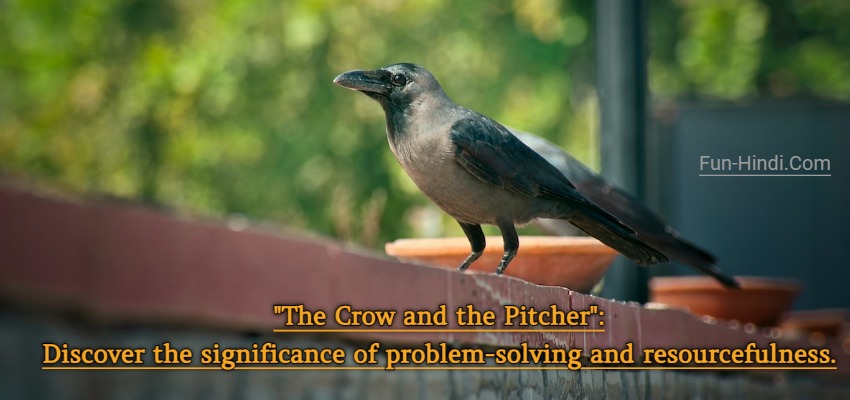
“The Crow and the Pitcher”: Discover the significance of problem-solving and resourcefulness.
“The Crow and the Pitcher” is a fable that tells the story of a thirsty crow and its clever solution to quench its thirst. One scorching day, a crow happened upon a pitcher in the garden. It was filled with water, but the water level was too low for the crow to reach.
The crow tried pecking at the pitcher, hoping to tip it over and drink the water. However, its efforts were in vain as the pitcher was heavy and stable. The crow began to lose hope, feeling desperate and dehydrated.
But the clever crow didn’t give up. It had an idea. It picked up small pebbles from the ground and dropped them into the pitcher one by one. With each pebble dropped, the water level gradually rose.
The crow repeated this process until the water level reached a height at which it could finally take a refreshing sip. The crow’s ingenuity and resourcefulness saved the day.
The moral of the story is that problem-solving and resourcefulness can help overcome difficult situations. It teaches us to think creatively and find solutions instead of giving up easily. The crow’s ability to use the pebbles to raise the water level highlights the importance of finding alternative approaches and using available resources wisely.
In this story, the important words are:
- Crow: Represents an intelligent and resourceful character.
- Pitcher: A container holding water.
- Thirst: Feeling of needing to drink.
- Quench: Satisfy one’s thirst.
- Peck: To strike or tap with a beak.
- Vain: Unsuccessful or futile.
- Desperate: Feeling a sense of urgency or hopelessness.
- Dehydrated: Lacking water and feeling extremely thirsty.
- Pebbles: Small stones or rocks.
- Ingenuity: Creative and clever thinking.
- Resourcefulness: The ability to find solutions using available resources.
- Alternative: Another option or approach.
- Approaches: Methods or ways of doing something.
- Wisely: Using good judgment and making wise decisions.
👉 Read also: Cow pr Essay in English
Conclusion:
With our short moral story translations from Hindi to English, students in Class 5, 9, and 10 can embark on a journey of language development, cultural understanding, and character growth. These stories offer valuable life lessons while nurturing linguistic skills. Immerse yourself in the world of storytelling and unlock the doors to language proficiency and cross-cultural appreciation. Start exploring our collection today and embrace the joy of learning through captivating narratives.
FAQ’s
Q: What is Moral Story Translation Hindi to English for Class 5, 9, and 10?
A: Moral Story Translation Hindi to English is a collection of short stories translated from Hindi to English, specifically tailored for students in Class 5, 9, and 10. These stories carry moral lessons and serve as a valuable resource for language learning, cultural understanding, and character development.
Q: Why is Moral Story Translation important for students in Class 5, 9, and 10?
A: Moral Story Translation plays a crucial role in the development of students’ language skills and cultural awareness. It helps students improve their vocabulary, grammar, and comprehension in both Hindi and English. Additionally, these stories promote cross-cultural learning, empathy, and instill important moral values.
Q: How can Moral Story Translation benefit students?
A: Moral Story Translation offers several benefits to students. Firstly, it enhances their language proficiency by exposing them to different vocabulary and sentence structures. Secondly, it fosters cultural understanding and appreciation by exploring themes and traditions unique to Hindi culture.
Q: How can Moral Story Translation engage students in learning?
A: Moral Story Translation provides an engaging learning experience through captivating narratives and relatable characters. The stories are carefully selected to spark students’ interest, making language learning enjoyable and immersive. By connecting with the stories’ themes and lessons, students are more motivated to actively participate in the learning process.
Q: Where can I find Moral Story Translation resources for Class 5, 9, and 10?
A: Our platform offers a collection of Moral Story Translations from Hindi to English specifically designed for students in Class 5, 9, and 10. You can access these resources on our website, where you’ll find a wide range of stories that promote language development, cultural understanding, and character growth.
Q: How can Moral Story Translation support character development?
A: Moral Story Translation exposes students to various ethical dilemmas and choices made by the story’s characters. By reflecting on these narratives, students learn valuable moral values such as honesty, kindness, perseverance, and more. These stories provide a platform for discussions on character development, enabling students to cultivate positive traits and make wise decisions in their own lives.
How did you like this information and post?
If you liked this post Short Moral Story Translation Hindi To English For Class 5, 9 And 10 or got to learn something, please share this post on Social Networks like WhatsApp, Facebook, Instagram, Telegram, Pinterest, Do share on Twitter, Google+ and other social media sites. Also subscribe my YouTube Channel.
|| Thanks |❤|…

